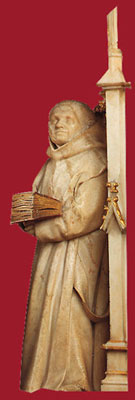With all this work on the Calvary and its support, progress was slow on the sepulchre of Philippe le Hardi. On 28 December 1402, a breach had been made in the apse wall to bring in the great slab of black marble on which the recumbent figure was to lie, but on the death of Philippe on 27 April 1404, the work was very far from finished.
The design, however, had been agreed and, as we have seen, after the death of Sluter, Claus de Werve undertook to execute it faithfully. Claus de Werve, interpreting his uncle's inspiration, has brought to life the concept of a funeral procession, which elsewhere had been reduced to a formula. The forty little figures of the mourners - les pleurants - are each highly individual, not only in the distinctive realism of their expressions, but in the seemingly inexhaustible variety of their draperies, which were accomplished with an artistry which is infinitely ingenious, which turns to good account the costumes themselves, so that the draperies contribute to the expression of the state of mind and the dramatic situation.
The architectural setting takes the form of a gallery in the finest Flamboyant tradition. To break the monotony of an uninterrupted arcade, a rhythm has been introduced between broad double archways and narrow triangular niches. In the shelter of these openings the figures of the pleurants are grouped, as if the funeral procession had halted and was standing at case. The alternation of the niches dictates the disposition of the figures, the triangular apertures containing only one figure and the double archways two.
These juxtapositions play an important part in the composition; "as they turn towards one another", wrote Pierre Quarré, "to exchange a few words or to make some gesture of consolation, or are turned in upon themselves in spiritual recollection, meditation or in an exalted moment of prayer, each one manifests his own grief with an astonishing variety of attitudes".
![]() One
of the greatest compliments to the work of Claus de Werve came from Philippe
le Bon when he, in his turn, wished to erect a similar
memorial to his father, Jean sans Peur, murdered on the bridge
of Montereau on 10 September 1419.
One
of the greatest compliments to the work of Claus de Werve came from Philippe
le Bon when he, in his turn, wished to erect a similar
memorial to his father, Jean sans Peur, murdered on the bridge
of Montereau on 10 September 1419.
In 1435, when Claus was still in office, an order was placed for twenty-two large pieces of black marble from Dinant, but four years later Claus died. Philippe le Bon chose as his successor Jehan de La Huerta, a native of Aragon who was currently working at Chalon-sur-Sa˘ne. He was commissioned to produce something 'as good if not better and of the same and as fine a stone as that of the late most excellent prince of noble memory'.
The tomb of Jean sans Peur is little more than a copy of that of his father. Jehan de La Huerta, having made a start, abandoned his work at the end of 1456. It took five years before his successor was appointed, and in 1461 the good duke gave the commission to Antoine le Moiturier of Avignon, with an obligation to complete his task in three years. It was not, however, until 1470 that the tomb of Jean sans Peur and his wife was finally installed in the Chartreuse de Champmol, which thus became the proud possessor of two of the greatest masterpieces of Burgundian art.
